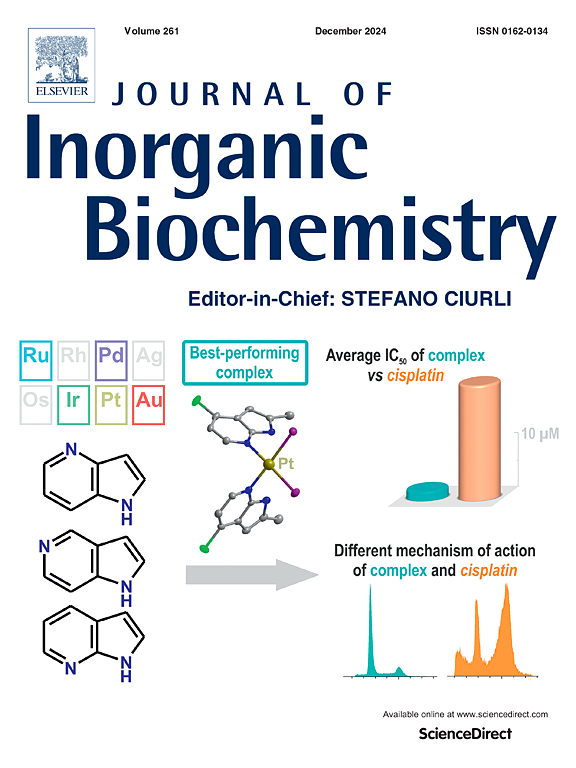Biomimics of [FeFe]‑hydrogenases: Diiron aza- versus oxadiphenylpropanedithiolate complexes with mono- versus diphosphines
IF 3.2
2区 化学
Q2 BIOCHEMISTRY & MOLECULAR BIOLOGY
引用次数: 0
Abstract
To extensively devolep the bioinspired chemistry of [FeFe]‑hydrogenases, this study performs an insigt into the selective substitution of all‑carbonyl diiron aza- versus oxadiphenylpropanedithiolate precursors Fe2(μ-Ph2xdt)(CO)6 (Ph2xdt = Ph2odt = (SCHPh)2O for 1 and Ph2adtNH = (SCHPh)2NH for 2) by mono- versus diphosphines P(C6H4R-p)3 (R = Me and Cl) and (Ph2P)2R′ (R′ = cis-CH=CH- for dppv and -CH2CH2- for dppe). With monophosphines, their monosubstituted diiron Ph2odt complexes Fe2(μ-Ph2odt)(CO)5){κ1-P(C6H4R-p)3} (R = Me for 1a and Cl for 1b) were obtained through the oxidative decarbonylating of 1 at room temperature in MeCN with Me3NO·2H2O; in contrast, analogous diiron Ph2adtNH complexes Fe2(μ-Ph2adtNH)(CO)5){κ1-P(C6H4R-p)3} (R = Me for 2a and Cl for 2b) were afforded via the photolytic decarbonlating of 2 under UV irradiation (365 nm) in toluene. With diphosphines, the dppv-chelated diiron Ph2xdt complexes Fe2(μ-Ph2xdt)(CO)4(κ2-dppv) (Ph2xdt = Ph2odt for 1c and Ph2adtNH for 2c) were prepared from the UV-irradiated decarbonylation of 1 or 2 in toluene; by contrast, the dppe-chelated diiron similar complexes Fe2(μ-Ph2xdt)(CO)4(κ2-dppe) (Ph2xdt = Ph2odt for 1d and Ph2adtNH for 2d) were synthesized from the Me3NO-assisted decarbonylation of 1 in room-temperature MeCN and that of 2 at refluxing toluene, respectively. The elemental analysis, FT-IR and NMR (1H, 31P) spectroscopy are used for the full elucidation of the molecular structures of these new diiron complexes and X-ray crystallography is applied for further confirmation of 1, 2 and 1a, 2b. The electrochemical properties of representative complexes 1, 1a, 1c and 2, 2a, 2c have been explored and compared with and without acetic acid (AcOH).

[FeFe]氢化酶的仿生学:偶氮偶铁与氧二苯基丙二硫酸盐配合物与单膦与二膦
为了广泛开发[FeFe]氢化酶的生物启发化学,本研究深入研究了全羰基二铁偶氮-与氧二苯基丙二硫酸盐前体Fe2(μ-Ph2xdt)(CO)6 (Ph2xdt = Ph2odt = (SCHPh)2O为1,Ph2adtNH = (SCHPh)2NH为2)与单-与二膦P(C6H4R-p)3 (R = Me和Cl)和(Ph2P)2R ' (R ' =顺-CH=CH-为dppv和- ch2ch2 -为dppe)的选择性取代。以单膦为原料,用Me3NO·2H2O将1在MeCN中室温氧化脱碳,得到单取代双铁Ph2odt配合物Fe2(μ-Ph2odt)(CO)5){κ1-P(C6H4R-p)3} (R = Me, 1b = Cl);通过紫外(365 nm)辐照,得到了类似的Ph2adtNH二铁配合物Fe2(μ-Ph2adtNH)(CO)5){κ1-P(C6H4R-p)3} (R = Me为2a, Cl为2b)。以二膦为原料,用紫外光照射甲苯中1或2的脱碳反应制备了dppv螯合的二铁Ph2xdt配合物Fe2(μ-Ph2xdt)(CO)4(κ2-dppv) (Ph2xdt = Ph2odt, Ph2adtNH = 2c);通过me3no辅助1在室温MeCN中脱碳和2在回流甲苯中脱碳,分别合成了二铁螯合物Fe2(μ-Ph2xdt)(CO)4(κ2-dppe) (Ph2xdt = Ph2odt为1d, Ph2adtNH为2d)。利用元素分析、FT-IR和核磁共振(1H, 31P)光谱对这些新的二铁配合物的分子结构进行了全面的阐明,并利用x射线晶体学对1,2和1a, 2b进行了进一步的确认。研究了具有代表性的配合物1、1a、1c和2、2a、2c的电化学性能,并比较了它们在加入和不加入乙酸(AcOH)时的电化学性能。
本文章由计算机程序翻译,如有差异,请以英文原文为准。
求助全文
约1分钟内获得全文
求助全文
来源期刊

Journal of Inorganic Biochemistry
生物-生化与分子生物学
CiteScore
7.00
自引率
10.30%
发文量
336
审稿时长
41 days
期刊介绍:
The Journal of Inorganic Biochemistry is an established international forum for research in all aspects of Biological Inorganic Chemistry. Original papers of a high scientific level are published in the form of Articles (full length papers), Short Communications, Focused Reviews and Bioinorganic Methods. Topics include: the chemistry, structure and function of metalloenzymes; the interaction of inorganic ions and molecules with proteins and nucleic acids; the synthesis and properties of coordination complexes of biological interest including both structural and functional model systems; the function of metal- containing systems in the regulation of gene expression; the role of metals in medicine; the application of spectroscopic methods to determine the structure of metallobiomolecules; the preparation and characterization of metal-based biomaterials; and related systems. The emphasis of the Journal is on the structure and mechanism of action of metallobiomolecules.
 求助内容:
求助内容: 应助结果提醒方式:
应助结果提醒方式:


